![]()
![]()
![]()
Use LEFT and RIGHT arrow keys to navigate between flashcards;
Use UP and DOWN arrow keys to flip the card;
H to show hint;
A reads text to speech;
88 Cards in this Set
- Front
- Back
|
Substage condenser
|
Focuses the incoming light beam into a cone of light so that it just fills the front lens of an objective. Increases the resolution of a specimen.
|
|
|
Iris diaphragm
|
Controls the amount of light used to view the object. Provides contrast.
|
|
|
Rheostat
|
A rotary dial on the right hand side of the base which is used to vary the amount of light emanating from the light source.
|
|
|
Working distance
|
The space between the objective lens and the stage when the specimen is in focus.
|
|
|
(mag objective) (mag ocular)
|
Total magnification =
|
|
|
(actual width of specimen) / (scale)
|
Drawing width
|
|
|
(actual length of specimen) / (length of drawing)
|
Scale
|
|
|
(calibrated value of one ocular division for that power objective) x (# of ocular divisions taken up by the specimens length or width)
|
Specimen length or width =
|
|
|
Carbohydrates, lipids, proteins, nucleic acids
|
The four types of macromolecules
|
|
|
Benedicts reagent
|
Tests for simple carbohydrates (sugar). Positive is green/brown /orange/red. Negative is blue.
|
|
|
Iodine
|
Tests for complex carbohydrates (starch). Positive is purple /black/brown. Negative is clear brown.
|
|
|
Sudan IV
|
Tests for lipids.
|
|
|
Biuret reagent
|
Tests for proteins. Positive is purple. Negative is light blue.
|
|
|
AgNO3
|
Tests for presence of chloride ions. Positive is a white precipitate.
|
|
|
Diffusion
|
The movement of a solute particle across a membrane from an area of higher concentration to an area of lower concentration.
|
|
|
Osmosis
|
The movement of water across a differentially permeable membrane, from the solution with lower solute concentration to the solution with higher solute concentration.
|
|
|
Hypotonic to Hypertonic
|
Water moves from
|
|
|
Because it only has a small number of molecules in a solution and therefore does not affect the concentration of water/the tonicity.
|
Why is starch osmotically inactive
|
|
|
(final-initial) / (initial) x 100%
|
Percent weight change =
|
|
|
Longitudinal and cross sections
|
Two sectioning planes
|
|
|
Carnoys fluid
|
This regarding the cell walls and chromosomes which were previously softened.
|
|
|
Hydrochloric acid alcohol
|
This separates the cells but has a side effect:it softens the cells other components and dissolves the mitotic spindle fibres.
|
|
|
Aceto-orcein
|
Stains the nuclear material
|
|
|
Bismark brown
|
Stains the cell walls
|
|
|
Peptodoglycan
|
Prokaryotic cells are composed of
|
|
|
Culture media
|
Used to grow bacteria.
|
|
|
Water, a nutrient solution, and algar
|
Contents of culture media
|
|
|
1. Size
2. Shape (circular or irregular) 3. Margin or edge (circular, rounded projections, or filamentous projections) 4. Surface texture (smooth, rough, wrinkled) 5. Elevation (thin or thick, convex or concave) 6. Color |
Characteristics of bacterial colonies (there are 6)
|
|
|
Rod (bacillus), sphere (cocci), spiral (spirillus)
|
Shapes of bacteria
|
|
|
They can convert N2(g) into NH3 which can then be utilized by plants and animals.
|
What do nitrogen fixing bacteria do
|
|
|
Cyanobacteria and symbiotic bacteria
|
Two types of nitrogen fixing bacteria
|
|
|
Cyanobacteria
|
Type of bacteria that are blue-green in pigment and contain heterocysts which are the site of nitrogen fixation.
|
|
|
Nostoc (Cyanobacteria)
|
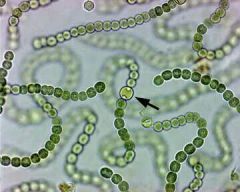
|
|
|
Symbiotic bacteria
|
Form symbiotic relationships with the roots of certain plants. Found in soil. Form root nodules.
|
|
|
Euglena
|
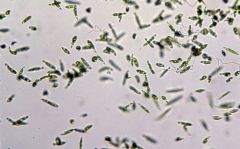
|
|
|
Paramecium
|
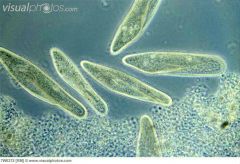
|
|
|
Amoeba or pelomyxa
|

|
|
|
Rhizopus Stolonifer
|

|
|
|
Aspergillus or penicillium
|
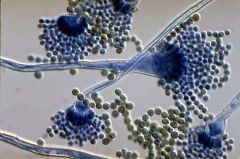
|
|
|
Mucor mucedo
|
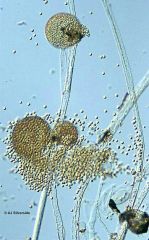
|
|
|
Peziza
|
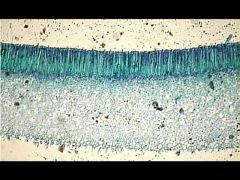
|
|
|
Agaricus bisporus
|
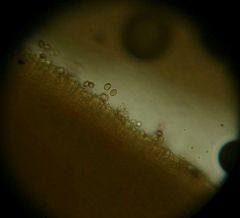
|
|
|
Photosynthesis
|
Radiant energy from the sun is converted to chemical energy and is used to form a carbohydrate. The carbohydrate can be used as fuel for respiration or as a precursor for any of the complex molecules of life.
|
|
|
Bicarbonate indicator
|
Measures changes in CO2 concentration
|
|
|
Lowered pH = yellow.
|
More CO2 =
|
|
|
Raised pH= purple.
|
Less CO2=
|
|
|
Decreases the rate of photosynthesis.
|
How does decreasing light intensity affect the rate of photosynthesis?
|
|
|
It would raise.
|
How is the concentration of CO2 altered by autotrophs in darkness?
|
|
|
It would decrease.
|
How is the concentration of co2 altered by autotrophs in strong light?
|
|
|
Paramecium, euglena, and pelomyxa or amoeba
|
Three types of protists
|
|
|
Single celled, heterotrophic, motile protists
|
Paramecium, euglena, and pelomyxa are all
|
|
|
Cilia
|
Type of locomotion in paramecium
|
|
|
Pseudopodia
|
Type of locomotion in amoeba
|
|
|
Flagella
|
Type of locomotion in euglena
|
|
|
Through phagocytosis. The cilia propels the food into a tiny mouth opening. The food is then stored in a vaculole.
|
How do paramecium feed? Explain.
|
|
|
Mixotroph (ex: euglena)
|
Protists that are able to feed through both heterotrophic and autotrophic methods.
|
|
|
Chlorophyll a, Chlorophyll b, and carotenoids.
|
Euglena possess these photosynthetic pigments
|
|
|
When acting as an autotroph, euglena utilize chloroplasts. Chloroplasts contain the green pigment chlorophyll.
|
Why are euglena green?
|
|
|
Blue. Because this is the wavelength that is the most strongly absorbed by the chlorophylls and carotenoids.
|
What color is best absorbed by euglena?
|
|
|
Green. Green is reflected. Photosynthesis is poor in the green region because the pigments do not readily absorb that wavelength.
|
Which color is euglena least attracted to?
|
|
|
Thallus, hold fast, stipe, blade
|
Parts of algae
|
|
|
Eukaryotic, absorptive heterotrophs, that reproduce using sexual and/or asexual spores.
|
All fungi are....
|
|
|
Mycelia
|
Multicellular fungi are composed of branched, thread-like hyphae, collectively called....
|
|
|
Asexual
|
This type of fungi reproduction occurs under favorable conditions
|
|
|
Sexual
|
This type of fungi reproduction occurs under nonfavorable conditions
|
|
|
Zygomycota
|
Rhizopus stolonifer and mucor mucedo fall under the phylum....
|
|
|
Ascomycota
|
Aspergillus or peniccilium and peziza fall under the phylum....
|
|
|
Basisiomycota
|
Agaricus bisporus falls under the phylum....
|
|
|
Phylum zygomycota
ASEXUAL Sporangium and sporangiospores |
Rhizopus stolonifer
|
|
|
Phylum zygomycota
SEXUAL Zygospores |
Mucor mucedo
|
|
|
Phylum ascomycota
ASEXUAL Conidia and conidiospores Hand like Formed from ascocarp |
Aspergillus or peniccilium
|
|
|
Phylum ascomycota
SEXUAL Ascospores Cup fungi |
Peziza
|
|
|
Phylum basidiomycota
SEXUAL Basidium Basidiospores |
Agaricus bisporus
|
|
|
Fermentation
|
Occurs when yeast is deprived of oxygen and can not carry out aerobic respiration
|
|
|
The breakdown of organic molecules to produce energy without the presence of oxygen
|
What is fermentation?
|
|
|
CO2(g)
|
What gas is being produced by the yeast?
|
|
|
Because the bicarbonate indictator changes color to yellow.
|
How do you know the yeast is producing CO2 gas?
|
|
|
Alcoholic fermentation, which results in CO2 and ethanol
|
By what process is the yeast producing CO2 gas?
|
|
|
The yeast uses the glucose for energy as it metabolizes it through glycolysis to produce the ATP needed to complete the process of fermentation.
|
What is the purpose of the glucose?
|
|
|
Test for alcohol.
|
How would you determine if the yeast has carried out fermentation or aerobic respiration?
|
|
|
A mutualistic relation between fungi and algae
|
Lichen is
|
|
|
A mutualistic relationship between fungi and the root of a plant
|
Mycorrhizae is
|
|
|
Fungi is provided with nutrients from the algae, algae is provided with protection by the fungi.
|
What is the beneficial relationship in lichen?
|
|
|
Crustae (flat like), fruticose (shrub like), and foliose (leaf like)
|
3 types of lichen are
|
|
|
1. Upper cortex (protection)
2. Algal layer (nutrients through photosynthesis) 3. medulla (storage) 4. Lower cortex (attaches lichen to substrate) |
The four parts of lichen are
|
|
|
1. Endomycorrhizae (Penetrates root cells, never forms sheath)
2. Ectomycorrhizae (never Penetrates root cells, forms sheath) |
Two types of mycorrhizae and explain
|
|
|
Problem
Hypothesis Prediction Procedure Results Discussion ( brief summary of results, linking of results to dependent variable, explanation of results, discuss the control, discuss improvements) Conclusion |
The outline of a lab write up
|
|
|
1. SAB (sabouraud dextrose agar) composed of glucose. Acidic. Used for fungi growth.
2. TSA (tryptic soy agar) composed of proteins and salt. Slightly basic. Used for bacterial growth. 3. YM (yeast Maltose agar) composed of yeast, malt, polypeptides, and glucose. Slightly acidic. Used for growth of fungi. |
Three types of culture media
|

